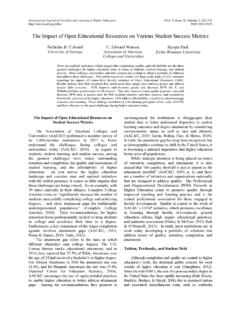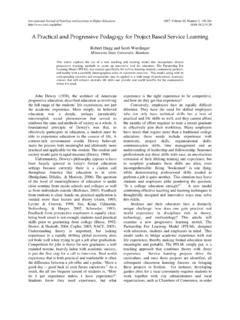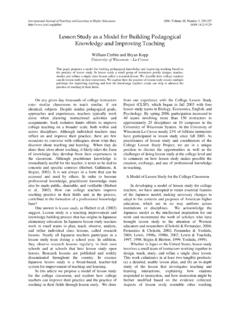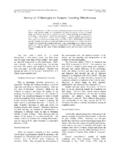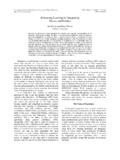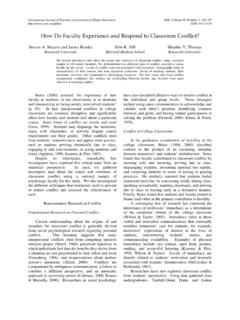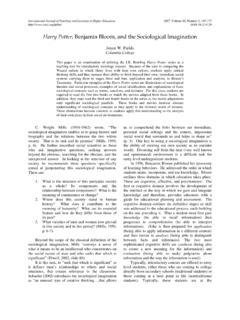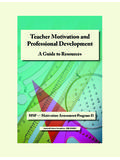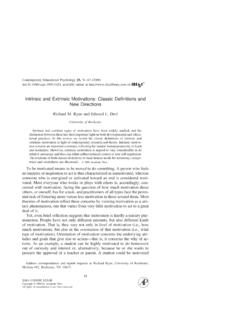Transcription of Motivating Students to Engage in Learning: The MUSIC …
1 International Journal of Teaching and learning in Higher Education 2009, Volume 21, Number 2, 272-285. ISSN 1812-9129. Motivating Students to Engage in learning : The MUSIC Model of Academic motivation Brett D. Jones Virginia Tech The purpose of this article is to present a model of academic motivation that can be used by instructors to design courses that will Engage Students in learning . The model, based on research and theory, consists of five components that an instructor should consider when designing instruction: (1) empowerment, (2) usefulness, (3) success, (4) interest, and (5) caring. In this article, I describe the components of the model by discussing the key concepts of the components, summarizing the background research and theories that support the importance of the components, and providing questions, suggestions, and examples that instructors should consider when designing instruction.
2 My hope is that novice, as well as experienced, instructors will find this model and the associated suggestions and examples useful as a reference tool to which they can refer when designing instruction. Although Students enroll in courses for a variety of to instructors in any academic discipline. I include reasons, and some Students have more initial interest in many practical suggestions and examples that course topics than others, the design of a course is the instructors can consider when designing their courses. I. key to whether or not Students are motivated to Engage did not want to write a dumbed-down article that in learning during the course. But what can instructors would present the reader with a checklist of things to do do to design courses that will motivate Students to to motivate Students because instructors must Engage in learning ?
3 In this article, I provide answers to understand why they are using particular instructional this question by presenting the MUSIC model of strategies. When instructors do not understand the academic motivation . The usefulness of the MUSIC theory behind the strategies, they are more likely to model is that it specifies five key components that can implement them incorrectly. Consequently, I provide guide instructors in making intentional decisions about some background research and theories for each the design of their courses based on current research component of the model. My hope is that novice as well and theories in the field of motivation . as experienced instructors will find this model and the As an educational psychologist, I teach courses and corresponding suggestions and examples useful as a conduct research related to motivation , teaching, and reference tool to which they can refer when designing learning .
4 When faculty members in other disciplines instruction. ask me about what they can do to motivate their Students , I try to give them a few suggestions. But when Academic motivation they ask for more information that they can read and apply to their courses fairly quickly, I have difficulty Psychologists have conducted research and locating appropriate resources for several reasons. First, developed theories of motivation to explain the the field of academic motivation is divided into many behavior of individuals. In the present article, I focus on mini-theories that can make it difficult for instructors the research and theories that are most applicable to to discern which ones are most relevant to their Students in academic settings, and thus I intentionally teaching.
5 For example, Reeve (2005) includes 24 use the term academic motivation to describe the motivation theories in his book. Second, because some model. Certainly, much of the research and many of the researchers define motivation concepts differently than theories upon which the model is based can also apply others (Schunk, 2000), it can be difficult for individuals to a wider range of behaviors, such as those unfamiliar with the field of motivation to readily demonstrated in athletics and work environments. understand and apply research results. This problem is I define academic motivation in a manner compounded by the fact that similar motivation consistent with Schunk, Pintrich, and Meece (2008) in concepts are often labeled with different names ( , which motivation is a process that is inferred from expectancy and self-efficacy).
6 Finally, much of the actions ( , choice of tasks, effort, persistence) and research has been more theoretical than applied, which verbalizations ( , I like biology. ), whereby goal- is appropriate for scholars in the field of motivation but directed physical or mental activity is instigated and not for instructors seeking practical advice. sustained. Academic motivation is not important in and My aim in the present article is to address these of itself, but rather it is important because motivated access barriers by summarizing the major tenets of Students tend to Engage in activities that help them to academic motivation in a manner that is understandable learn and achieve highly in academic settings. For Jones MUSIC Model of Academic motivation 273.
7 Instance, motivated Students are more likely to pay for Students to be motivated. However, research attention during course activities, take the time to use indicates that some of these components are highly effective learning and study strategies, and seek help correlated in some contexts ( , Kaufman & Dodge, from others when needed (Schunk et al., 2008). 2009), that more than one component can be used to explain a student's motivation ( , Griffin, 2006;. The MUSIC Model of Academic motivation Walker, Greene, & Mansell, 2006), and that the components can work together to produce higher levels The MUSIC model of academic motivation of motivation than when implemented alone ( , consists of five components that an instructor should Simons, Vansteenkiste, Lens, & Lacante, 2004).
8 Thus, I. consider when designing instruction: (1) empowerment, contend that the more that instructors can do to address (2) usefulness, (3) success, (4) interest, and (5) caring. all five of the components, the more successful they The name of the model, MUSIC , is an acronym based will be in Motivating all of their Students . Lastly, I have on the second letter of eMpowerment and the first no reason to believe that these components are less letter of the other four components. I derived each important for online courses than for traditional face-to- component of the model from research and theory in face courses. areas such as education and psychology. Although In the following sections, I describe the researchers have learned quite a bit about what components of the model by: discussing the key motivates individuals, much of this research has been concepts of the components, summarizing the conducted outside of higher education classrooms.
9 Background research and theories that support the Therefore, to provide a model based on the latest importance of the components, and providing questions, research and theory available, I examined research and suggestions, and examples that instructors should theories from within and outside of higher education. consider when designing instruction. The section titles My contribution in developing the MUSIC model for the components begin with the word Design . is primarily in analyzing, evaluating, and synthesizing because instructors can intentionally design learning motivation research and theory into one cohesive environments to foster Students ' motivation . The design model. I include the five components together in one might not work perfectly for every student, but research model because research and theory indicate that when and theory indicate that the five components of this instructors foster one or more of these components, model are important to Students ' motivation .
10 The Students are more motivated to Engage in their learning , questions listed in the Design sections are intended to which results in increased learning (see Figure 1). This provide instructors with questions that they should ask model is based on a social-cognitive theoretical themselves before, during, and after a course (if they framework that specifies that Students have plan to teach it in the future). The suggestions in the psychological needs, that characteristics of the social Suggestions sections are strategies that instructors can environment affect how these needs are met, and that implement to address the questions. Some suggestions satisfying these needs affect their perceptions and are more appropriate for some courses than others, behaviors.

